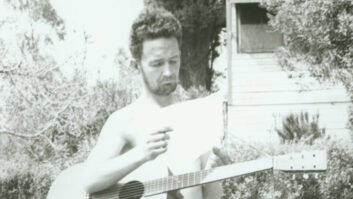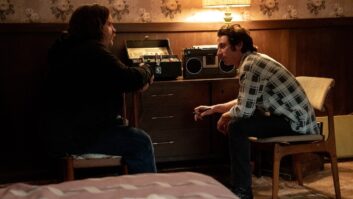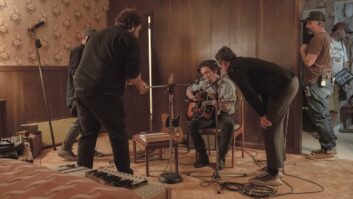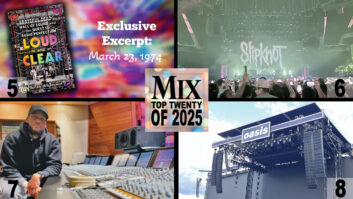Speaking at the “21st Century Vinyl” Panel at AES were (l-r) Pete Lyman, JJ Golden, Scott Hull, Jonathan Wyner. LOS ANGELES, CA—Jonathan Wyner of M Works Mastering in Boston, moderating the “21st Century Vinyl” workshop at the recent AES Convention, noted that vinyl sales this year are on track to eclipse 2013’s sales figures. “Are any of you brave enough to say whether this is going to go on for a while?” he asked the panel.

“I don’t think it’s going to be over for a while,” said Pete Lyman of Infrasonic in Los Angeles. “I always say that vinyl is the last viable physical format; there’s no need for anything else. Vinyl is more than just a listening experience, it’s a piece of art.”
The resurgence in vinyl sales certainly shows no signs of slowing. According to Nielsen Soundscan, U.S. vinyl sales were up for the sixth consecutive year in 2013, increasing 33 percent over 2012’s figures. Yet the numbers are relatively insignificant, representing only two percent of all physical album sales in the U.S. The best-selling LP title in the U.S. for 2013, Random Access Memories by Daft Punk, sold only 49,000 copies (but an impressive 19,000 in its first week). Worldwide, last year’s vinyl sales totaled $171 million, a tiny fraction of the industry’s $16.4 billion global revenue stream.
Even with the convenience and portability of CDs and MP3s, and a younger generation that grew up without analog audio formats, said JJ Golden, Golden Mastering, Ventura, CA, “A lot of the bands that we all talk to sell a lot of [vinyl] as merchandise when they’re on tour. The fans are asking for it; that’s what justifies making the investment into vinyl.”
“It’s kind of universal that they’re selling vinyl at the merch table more aggressively than any other physical [format]. And it can be bundled with the digital download,” observed Scott Hull, Masterdisk, New York.
Wyner noted that vinyl’s RIAA curve results in “something that’s as close as possible to an accurate phase representation”—much more so than CD, MP3 or tape. “I feel like when vinyl is done right, it’s a truer representation of analog music,” agreed Lyman. “I think people, even though they don’t physically know why it sounds better, are drawn to that. I think it’s just more musical.”
But as Golden commented, “It can sound better—it doesn’t always sound better.” There are many variables, he noted, including production choices, decisions made during the cut and whether the artist is trying to fit 25 minutes on a side or maximizing fidelity at 18 to 20 minutes in length. Then, on the reproduction side, he said, “You’ve got different cartridges, different needles, different needle shapes, different players, different preamps, different speakers—there’s a lot of things that influence whether a record sounds good or not.”
The length of an album side has an effect on the level and the noise floor, of course, but there are many other variables at play. “It’s not a fixed thing; it’s all very program-dependent,” said Hull.
There is one way to reduce the impact of those variables: “Always get a reference disk,” said Lyman. “Everyone’s in such a rush to get their record out; I can’t believe people skip this. You wouldn’t send your mixes to a mastering engineer and have them send it directly to the duplication plant—that would be insane. But that’s routinely what people do for vinyl.”
Hull reported, “I have added a new service. I will cut the references and give you my personal evaluation. We try it on several turntables, and with a few different cartridges.”
The vinyl resurgence is putting pressure on the relatively few remaining pressing plants. Lyman conjectured that a plant might be pressing 10,000 records a day. “Back in the ’80s, all 10,000 of those records might be Michael Jackson’s Thriller. Now you’ve got 10,000 records being pressed for 15,000 artists. The plants aren’t managing one project, they’re managing thousands, at the same capacity. I feel bad for the plants. All of that affects quality.”
Hull noted, “The cheapest [pressing plant] at the moment is usually the one that’s not booked up that heavily and not producing the most amazing results. Which means that you really have to think in advance of your release.”
Engineers mastering for vinyl currently face other challenges, according to Lyman. “There’s only one lacquer supplier now in North America, and only two in the world, and there really aren’t that many options for styli.” Further, under pressure from the medical industry, plastics manufacturers have removed the lead from PVC, which is what helped keep records quiet. “Plants are going to have to figure out a way to get the records quiet now,” said Lyman.
“If you do have a dynamic record, maybe some orchestral stuff, the noise floor can be a real issue,” said Golden. “If quality is a concern, investigating different plants that have the ability to press a quiet record to suit that particular project would be important.”
As the panel noted, there are mastering engineers advertising vinyl premastering services. “It doesn’t make any sense to just slap an elliptical filter on it because someone told you that’s what you should do,” said Lyman.
Hull stressed, “Unless you’re sitting there at the lathe, looking at the way the lathe and the groove is responding to the material you’re cutting, you don’t know whether you’re mastering properly for vinyl. Leave as much of it to us as possible.”
AES
aes.org







